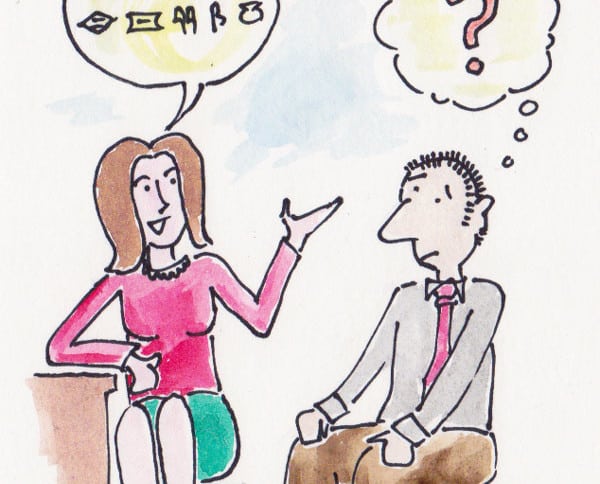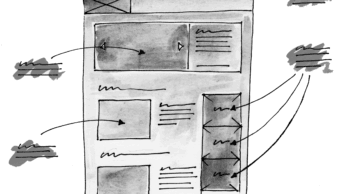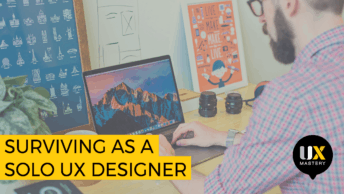I’ve sat in meetings where I was continually interrupted by a new boss who critiqued and clarified my work to a client without knowing the history of the project.
Though it was frustrating to feel like I wasn’t trusted to do my job, it inspired me to look into the ways that people make decisions and why we so often feel “right” after we’ve made our decision.
The anxiety we feel when threatened extends to the workplace when our ideas are challenged – our defences go up and we search for a way to deal with the threat. Some of the more well-known responses are the fight-or-flight, and the closely related freeze and appease response.
Because this process is largely unconscious, I want to shed light on what’s happening behind the scenes, so that we can better understand why we react this way during design reviews.
How can we learn to win the battle between thoughts and feelings during design reviews?
In this article, I’ll look at what I call ego-based design and evidence-based design approaches to decision-making, and suggest strategies for diffusing those difficult design review meetings.
Characteristics of ego-based design
Ego-based design decisions are made from the gut. This kind of decision-making doesn’t get talked about much, under the assumption that we’re all doing it.
How ego might feel at work
It can seem arbitrary when we first encounter ego-based design decisions. I’ll explain using a scenario.
Say you’re presenting your work at a design review. You’ve spent the last week working on revisions approved by your team. You proudly present your work when your boss interrupts: “I don’t like teal!”
You’re taken aback. Internally, you know this was the approach agreed upon by the entire team. You respond: “We agreed to use brand colours. That’s teal. The others don’t work.” Your boss’s response?
“That’s not my problem. You’re the designer. Figure it out.” The conversation is cut short.
You defended your position based on what you knew, as did your boss. Except he also called upon his authority. You both fought to support your side in the conversation, but unfortunately, you failed to connect.
We may not necessarily know the reason for our boss’s opinion, but we know it’s strongly held. When we learn how we react, we can better understand the context for that decision.
Supporting ego in our decisions
Even though you both felt you did the right thing, how can you communicate well and stay true to your feelings?
Take some time to consider other perspectives. Maybe a cup or tea or a few deep breaths would help. Take care of yourself before you approach the situation. Let’s try it again.
Imagine the conversation again starts with you proudly presenting your work. Again, your boss interrupts, “I don’t like teal!”
This time, you pause before you respond and assess the situation. You share, “We agreed to use brand colours,” and this time you add, “I’m curious. Why don’t you like teal?” This changes the tone of the conversation.
Your boss reveals, “We tested it three years ago. Employees hate teal.”
Now you’re getting to the heart of the issue. You make sure he is heard, “Okay. Three years ago, employees didn’t like teal.” Again, you add curiosity, “If you’re open to it, could we test it again?” He considers, “Well… Yes, I suppose so. We could.”
This time, we achieve a positive outcome without far less conflict. When we recognise each other in a conversation, we can meet creatively. Rather than give into our survival strategy to fight, we brought curiosity to the conversation, which revealed information we might have otherwise missed. We moved to an agreement that supports your work as a designer as well as your boss’s authority. Everyone involved understands why certain decisions were made.
The nuances of evidence-based design
Evidence-based design reflects our interpretation of fact. It constitutes both the situation we find ourselves in as well as our reaction.
Consider a butterfly as an example. It’s a sunny day and you’re outside having a picnic with a friend. A butterfly lands on the table near you. If you enjoy butterflies and nature, it’s a wonderful moment you can share with your friend. If on the other hand, you are terrified of bugs, then you might run away leaving your friend to worry.
Facts work the same way. Our reaction passes quickly through our nervous system and depends on our previous experience. We are each unique in how we make decisions from data and yet we so often treat these decisions as if they were objective.
Evidence at work
Imagine you’ve just finished a month of usability studies and participant interviews. You’re ready to make changes to the design. After presenting the findings to your boss, you say, “We know customers are abandoning the flow here and here. Now we’re ready to get started.”
A stickler for metrics, your boss asks, “Do we have task completion numbers?” Unfortunately, you do not. Your boss tells you, “We can’t make changes. We have to have those numbers.” Both of you are correct.
You’re confident about the changes that need to be made because you ran the studies. Your boss, however, is not. She’s focused on the task completion numbers. Counter-intuitively, more information might have helped your boss understand your instinct. Let’s try out a different ending to the conversation.
Listening to evidence and ourselves
When your boss tells you, “We can’t make changes until we have those numbers,” it’s an opportunity to explore. She’s feeling the need to have more information before making changes. Support that. Be clear and give insight:
“Even though we don’t have the numbers, I suggest we make changes soon to hit our deadline. We don’t have task completion numbers because the pilot wasn’t built with testing in mind. We can work on the design while the development team prepares for the test. I’m confident we can get both delivered and the data will support our changes.”
Your boss takes a moment to consider, “So, we can’t get the numbers yet?” “No, but we can make design changes while another team works on getting those numbers.” Seeing that you’ve established a way forward, she agrees, “Okay. Let’s try it.”
Adding the correct information makes compromise easy. Sometimes, wading through instinct and our emotional reactions can take time. But, you can recognize that data needs some emotion to make it feel right. Ensure your instinct as a designer can be heard when recognizing evidence.
Learning so we can connect
We need to listen to our instincts and cut through the noise. Ego-based design and evidence-based design are just two lenses for looking at how we relate during design reviews.
It sucks to have your work harshly criticised. More than once, I’ve been frustrated and wanted to leave a meeting where that was happening.
Yet things changed, even with the new boss that didn’t trust me. We took time to understand and listen to each other. It took effort, but we created a relationship where I felt open to express my job needs without fear of retribution and my boss felt comfortable asking questions when he didn’t know the answer during meetings.
It can be difficult, but it gets better. None of these were actual life-or-death situations, but when your job pays the bills, it can feel that way.
Try out some of these communication ideas and see if it brings harmony to your teams.
If you have similar stories, leave a comment or share your thoughts in the forums.





